Women In Technology Statistics 2024 By Sector, Companies, Education and Countries
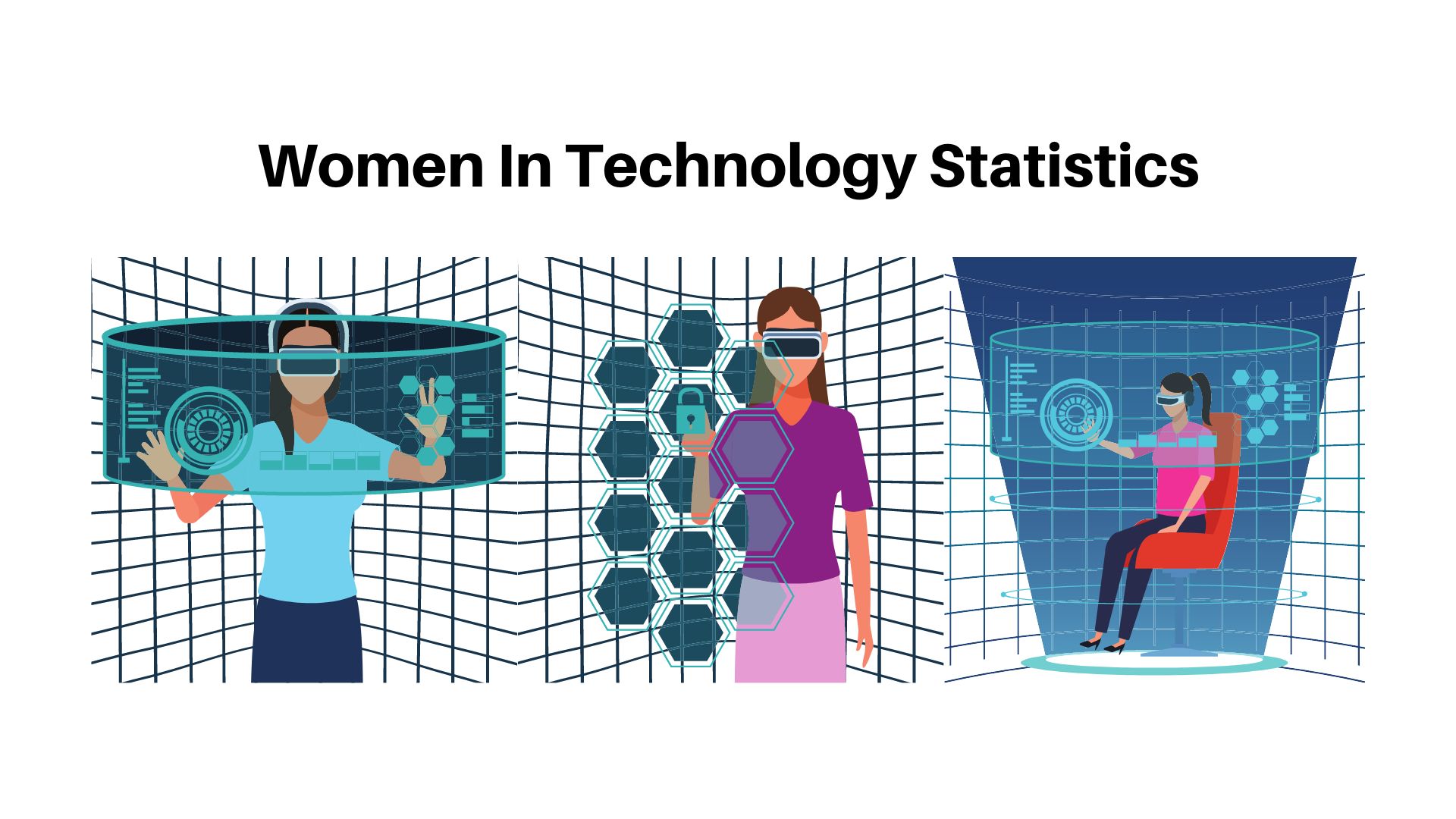
Page Contents
- Introduction
- The Women Who Changed The TECH WORLD
- Editor’s Choice
- You May Also Like To Read
- Facts About Women In Technology Statistics
- General Women In Technology Statistics
- Women in Technology Statistics By Sector
- Statistics By Company
- By Country
- By Education
- By Encouragement
- By Challenges
- By Job Satisfaction Factors
- By Skills
- Trends In Women in Technology
- Recent Development in Women in Technology
- Conclusion
Introduction
Women in technology statistics: The significant role that women play in the technology sector and to understand the prevailing statistics that shape their participation in this industry. According to recent data, women remain underrepresented in technology-related fields, with only 27% of workers in computer science roles being female. This disparity extends to leadership positions, where women hold just 19% of technical roles in the top tech companies.
Despite efforts to bridge this gap, the gender pay disparity persists, with women in technology earning only 82 cents for every dollar earned by their male counterparts. Moreover, the lack of representation is reflected in venture capital funding, with female-founded startups receiving just 2.3% of total VC funding in 2021. These statistics underscore the need for greater diversity and inclusion initiatives within the technology industry to harness the full potential of female talent and drive innovation forward.
The Women Who Changed The TECH WORLD
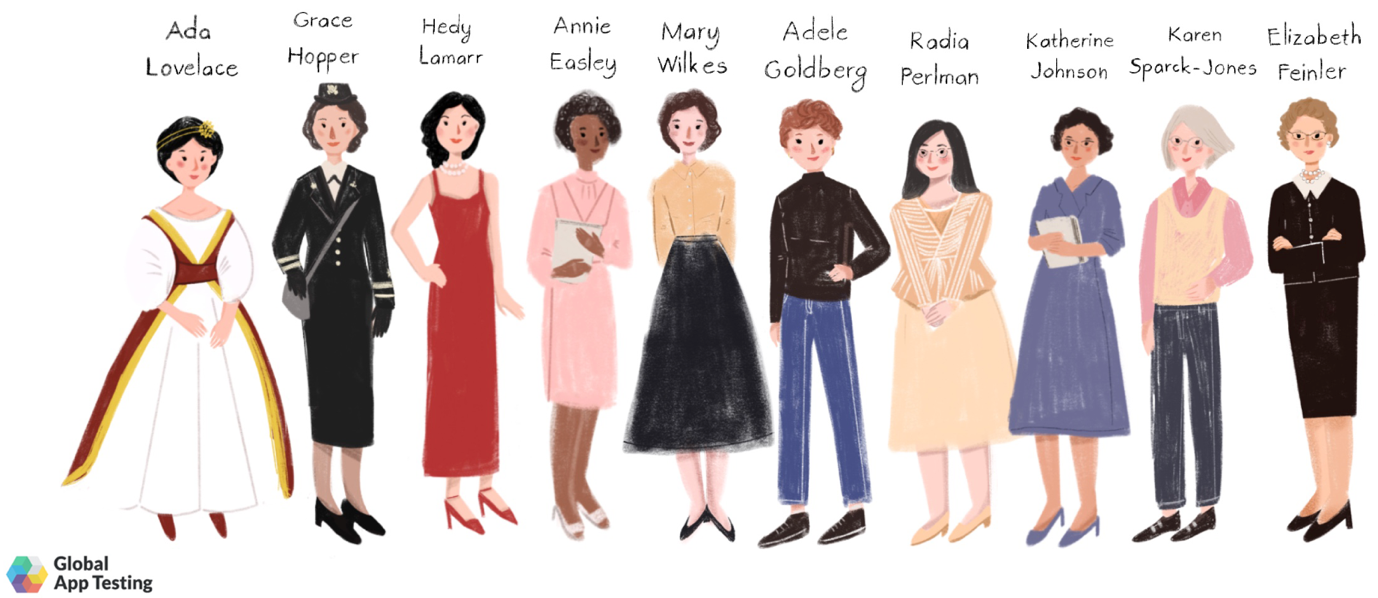
(Image Source: Global App Testing)
1. Ada Lovelace
Ada Lovelace (1815-1852) was an English mathematician and writer, widely regarded as the world's first computer programmer.
2. Grace Hopper
The brain behind the COBOL programming language, also Grace recognized the first-ever computer bug.
3. Hedy Lamarr –
Invented a secret communication system that led to ideas for WIFI and Bluetooth.
4. Annie Easley –
The rocket Scientist at NASA contributed to major projects leading to the basis of space shuttle launches.
5. Mary Wilkes –
Recognized as a designer of the software for LINC, further recognized as the first woman to use a computer at home.
6. Adele Goldberg –
Inventor of the Graphical user interfaces (GUI) concepts per Smalltalk-80 programming language.
7. Radia Perlman –
Invented the algorithm behind Spanning Tree Protocol (STP), on which the internet is functioning today.
8. Katherine Johnson –
The NASA mathematician spread the foundations for the US’s first flight.
9. Karen Sparck-Jones-
Developed information science of Inverse Document Frequency (IDF) which tells the importance of a word for the document.
10. Elizabeth Feinler –
developed original yellow and white page directories. Developed domain names such as .com, .net, .gov, and .edu.
Editor’s Choice
- As of today, Fortune has recognized 37 women among the Fortune 500 companies.
- In 2021, the highest number of applications from women for tech jobs were received for JavaScript, Java, and Python.
- 34% of women prefer to work remotely, citing increased efficiency.
- According to Women Tech, it is estimated to take approximately 133 years to close the economic gender gap.
- 28% of women leave tech jobs due to a perceived lack of career growth opportunities.
- 93% of capital investment in tech companies goes to those founded by men.
- In 2022, reported percentages of women in STEM fields include 25% Asian, 5% Black, 66% White, and 1% Hispanic.
- 39% of women feel that gender bias hampers their chances of promotion.
- Approximately 1.5 million females are employed in tech companies in the United States.
- 44% of women earned STEM-related degrees in 2022.
- Women currently hold 26.7% of tech-related jobs.
- In companies with more than 10,000 employees, women's representation in tech stands at 26.2%.
- The percentage of women in tech roles has decreased over the past two years.
- Women in software engineering earn 0.93 cents for every dollar earned by men in the field.
- Despite equal access, women receive just 18% of new computer science degrees.
- Companies with voluntary gender equality training hire fewer women than those with mandatory training.
- More than 50% of women in tech report experiencing gender inequality, discrimination, or sexual harassment.
- Women received only 1.9% of venture capital funding for all-women startup teams in 2022.
- Black women CEOs are paid 38% less than white male CEOs.
- 50% of women in tech leave their jobs before the age of 35.
- 32% of women in technical and engineering roles are often the only women in the room at work.
- Businesses with diverse executive teams are 25% more likely to have above-average profitability.
You May Also Like To Read
- Part-time Vs Full-time Employment Statistics
- Bureau of Labor Statistics
- Remote Work Statistics
- Vacation Rental Statistics
- Career Change Statistics
- Job Growth Statistics
- Job Interview Statistics
Facts About Women In Technology Statistics
- Representation: Women make up approximately 33% of the tech-related workforce.
- Educational Pursuits: Despite equal access, women receive only 18% of new computer science degrees.
- Venture Capital Funding: Women founders received just 1.9% of venture capital funding for all-women startup teams in 2022.
- Gender Pay Gap: Black women CEOs are paid 38% less than white male CEOs.
- Job Turnover: Around 50% of women in tech leave their jobs before the age of 35.
- Workplace Challenges: More than 50% of women in tech report experiencing harassment, sexism, or discrimination.
- Diversity: Only 3% of women in tech identify as Black, while 1.7% identify as Latinx.
- Investment Trends: Women founders receive just 2% of VC funding, highlighting disparities in investment allocation.
- Industry Trends: The percentage of women in tech leadership roles has decreased to 28% in 2023.
- Diversity Benefits: Businesses with diverse executive teams are 25% more likely to have above-average profitability.
General Women In Technology Statistics
- In the year 2021, applications from women received in tech jobs were highest for JavaScript, Java, and Python.
- As of 2022, the reported percentage of women working in STEM (Science, Technology, Engineering, and Mathematics) belonged to 25% Asian women, 5% black background,66% white, and 1% Hispanic women.
- It has been observed that, when companies have gender-diverse teams, they are 73% better at business decisions.
- As of today, Fortune has listed 37 women in the Fortune 500 companies.
- 40% of the women say that companies don’t give much importance to diversity in the workplace.
- Women in technology statistics say that there is 28.8% of women technologists in tech companies.
- 50% of women leave tech jobs by the of 35 years.
- The percentage of women leaving tech jobs is higher than men resulting in 45%.
- Around 19% of senior vice presidents are in tech firms and 15% are CEOs.
- 60% of the women working in STEM handle house chores along with job responsibilities.
- 34% of the women prefer to work remotely giving them more efficiency.
- US’s largest tech companies such as Google, Apple, Amazon, and Facebook have a collective ratio of 34.4% female workforce working with these companies.
- Considering the promotion, 39% of the women say that gender bias prevents them from rising to another position.
- Female participation in the STEM field includes math (47%), health (74%), physical science (40%), computer (25%), and engineering (15%).
- The ratio of males to females in the tech industry is 3:1 as of today.
- The global workforce states that there are 40% of the women in tech and 60% belong to men.
- 93% of the capital investment went to male-founding tech companies.
- According to Women Tech, it will take around 133 years to close the economic gender gap.
- 28% of women leave tech jobs because of the lack of career growth.
- Fortune 500’s list has 15% of female CEOs as of March 2022.
- Small tech companies are more female-dominated.
- In the United States of America, around 1.5 million females work in Tech companies.
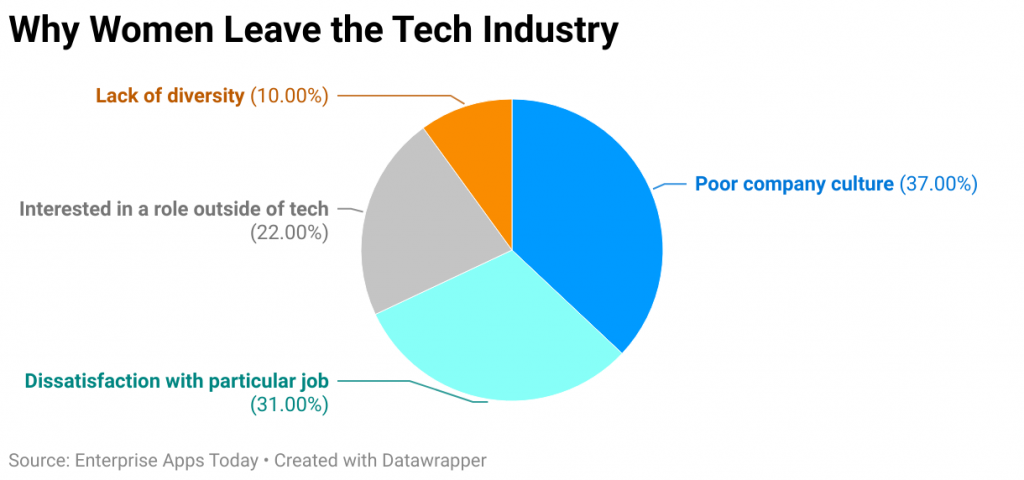
(Source: ZIPPIA)
- Women in technology statistics say that female tech employees leave the company majorly to poor company culture.
- 31% of the women in technology said they are not satisfied with the particular role they are offered.
- 22% of the female population in tech companies have received a better opportunity which is outside the tech.
- And remaining 10% say they feel there’s a lack in the company’s diversity.
Women in Technology Statistics By Sector
- As of 2022, 28% of the women in the United States of America are working in computing and mathematical jobs.
- 15% of the engineering jobs are captured by women around the world.
- Women in technology statistics say that 44% of women have earned STEM-related degrees in the year 2022.
- Women in the ICT sector earn less than men resulting in 19%.
- In the United States of America, there are 18% of women have a computer science background.
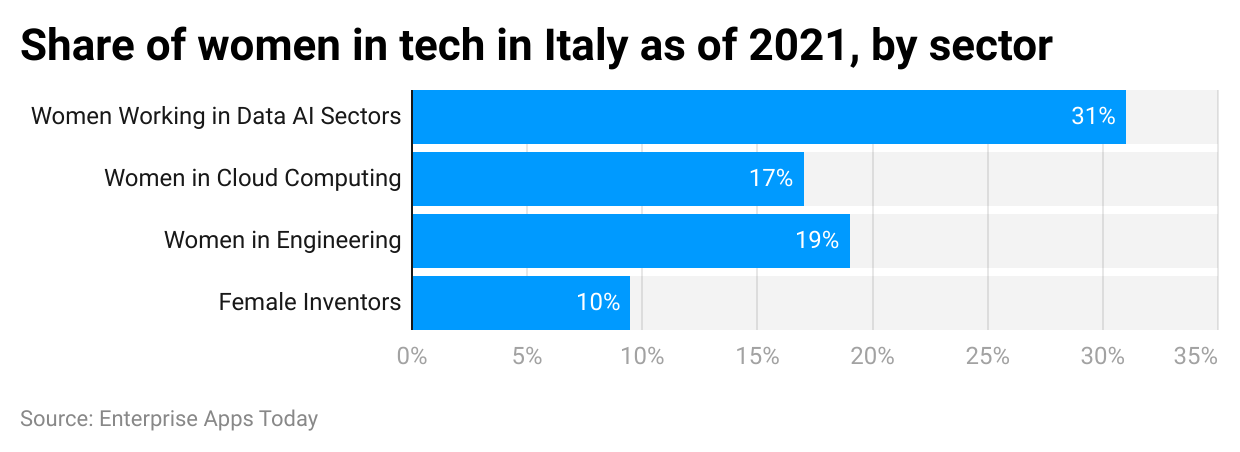 (Source: Statista)
(Source: Statista)
- In the year 2021, women in technology statistics say that the highest number of women working in the data and AI sector in Italy was 31%.
- 17% of the women were working in cloud computing.
- Similarly, as of 2021, 19% of the women were working in engineering and 9.5% of the women were investors.
Statistics By Company
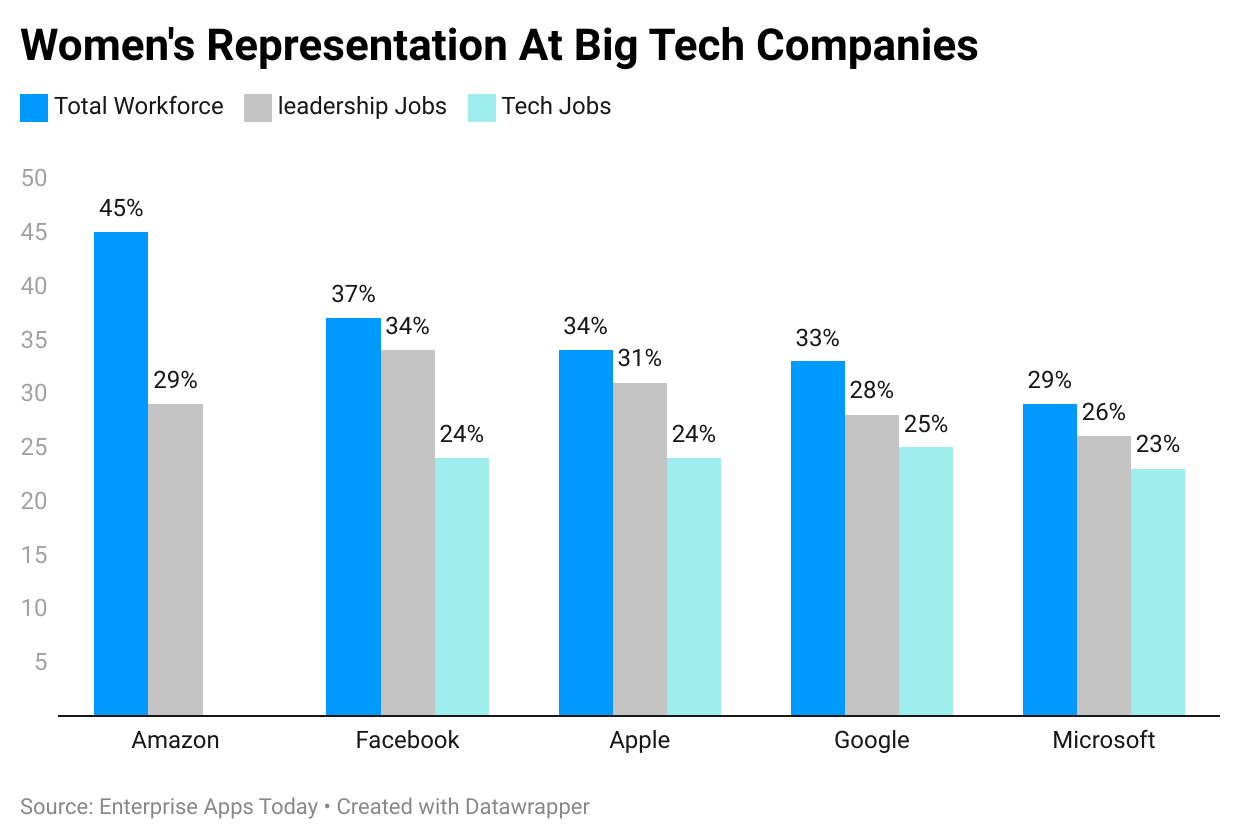 (Source: ZIPPIA)
(Source: ZIPPIA)
- Amazon has 45% of the total workforce while only 29% are offered leadership roles.
- Further, women in technology statistics say, that other big companies such as Facebook have 37% of the total workforce, while 34% are leadership jobs and 24% belong to tech jobs.
- Apple has 24% of the total workforce while 31% are leadership jobs and 24% are tech jobs captured by women.
- 33% of the total workforce is held by Google where 28% are leadership jobs and 25% are tech jobs.
- Microsoft holds 29% of the total workforce, while 26% are leadership jobs and 23% are tech jobs.
By Country
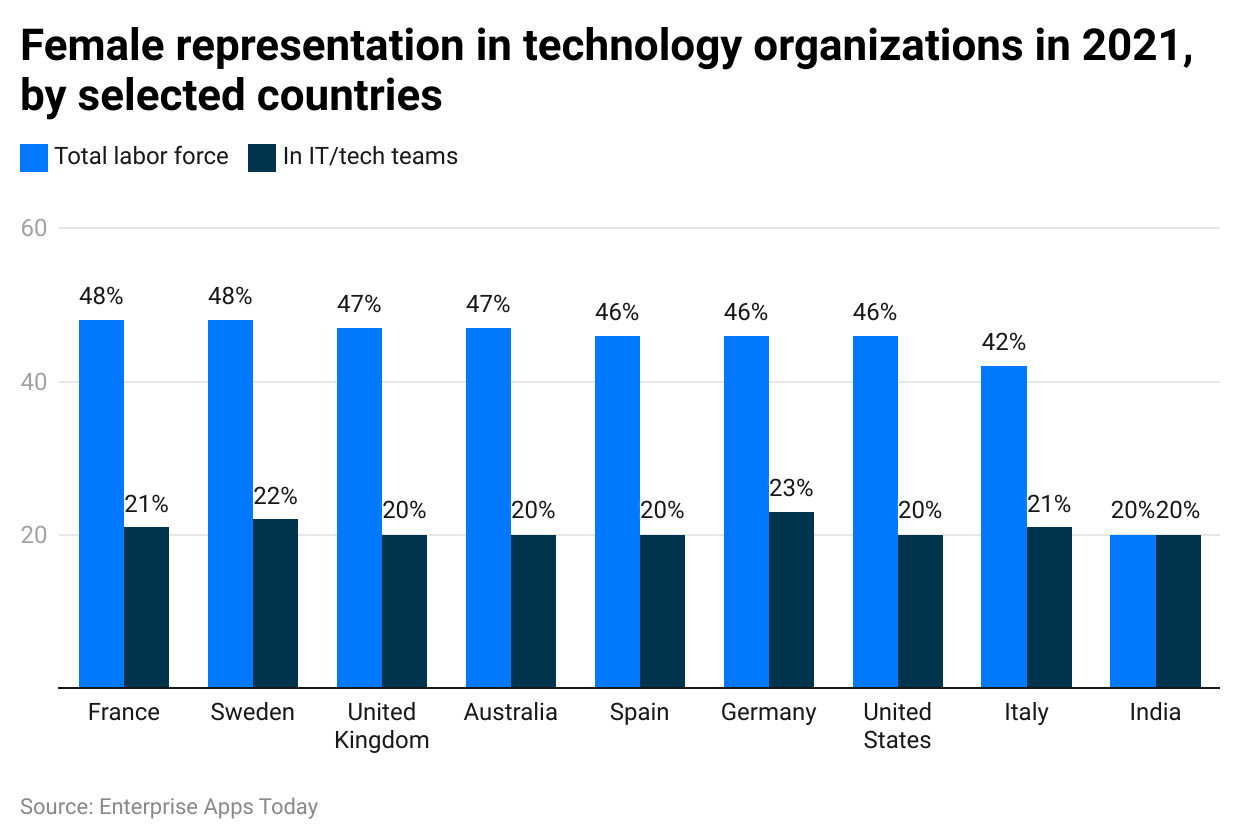 (Source: Statista)
(Source: Statista)
- According to Women in Technology statistics, as of 2021, France leads the way in overall female representation in the country for working in Tech firms.
- There are 48% of the total labor force in France and 21% of the females are employed in IT.
- Sweden has 48% of the total labor force whereas 22% are women working in IT.
- In the United Kingdom, 20% of the women belong to 47% labor force.
- Whereas other countries in the ratio of the total labor force to women in IT are, Australia – 47%: 20%, Spain – 46%: 20%, Germany – 46%: 23%, USA – 46%: 20%, Italy – 42%: 21%, and India 20%: 20%.
By Education
- On average, only 16% of the women suggested a tech career compared to 33% of the men.
- Only 3% of the women agree to a first-choice career in technology.
- More than a quarter of the female students left education in their Tech career saying it was too male-dominated.
By Encouragement
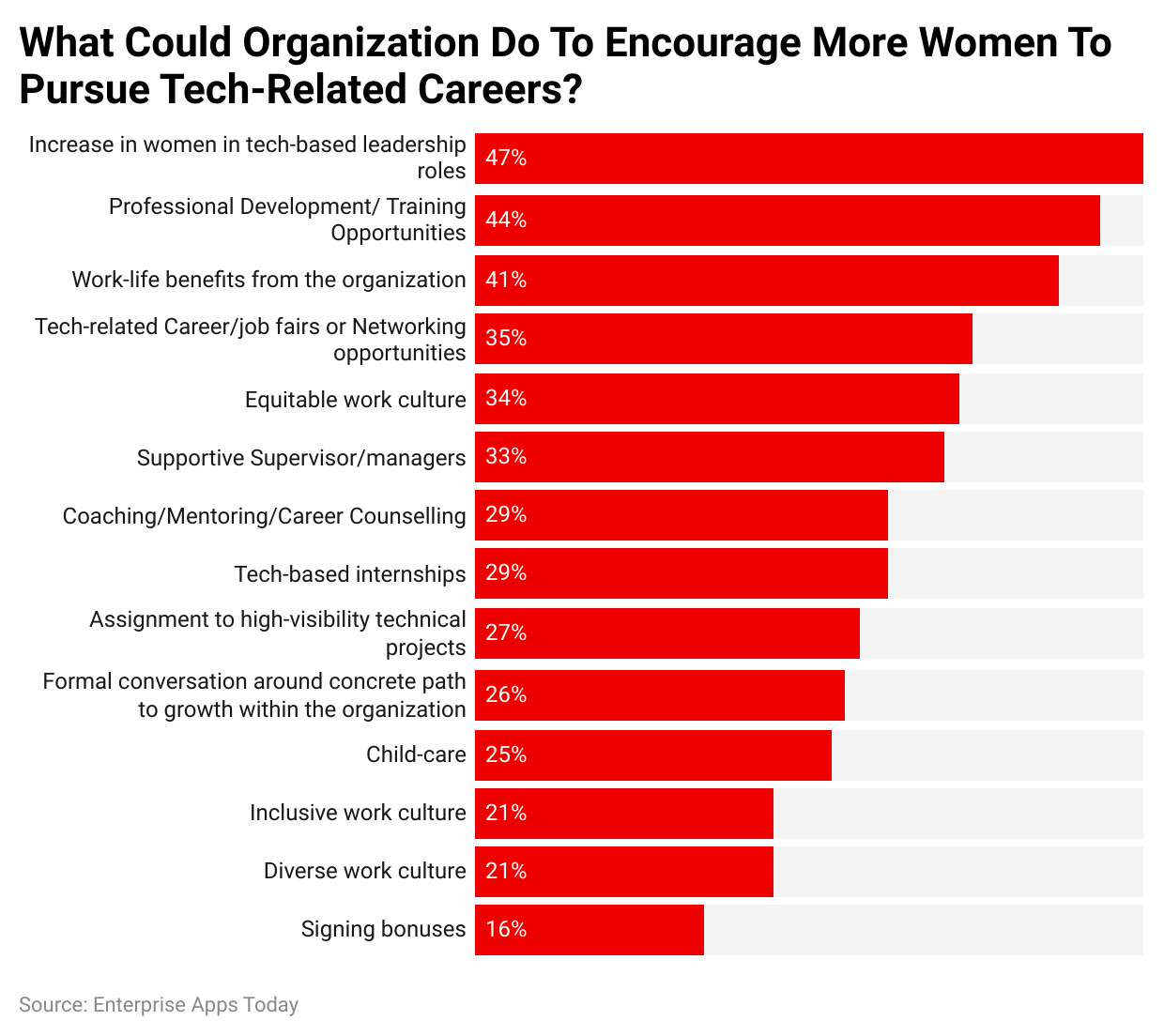 (Source: skillsoft.com)
(Source: skillsoft.com)
- 47% of companies are encouraging women to pursue tech-related careers by increasing tech-based leadership roles.
- 44% of companies around the globe focus on training opportunities while 41% of the companies provide work-life balance.
- Furthermore, women in technology statistics say that 35% of the companies provide networking opportunities while the remaining 34% give an equitable work culture.
- Other factors that encourage women to pursue a career in technology are having supportive managers (33%), career counseling (29%),tech-based internships (29%), highest visibility technical projects (27%), formal conversion (26%), childcare (25%), inclusive work culture (21%), diverse work culture (21%) and signing bonuses. (16%)
By Challenges
- 1 in 10 women working in tech companies reported sexual harassment.
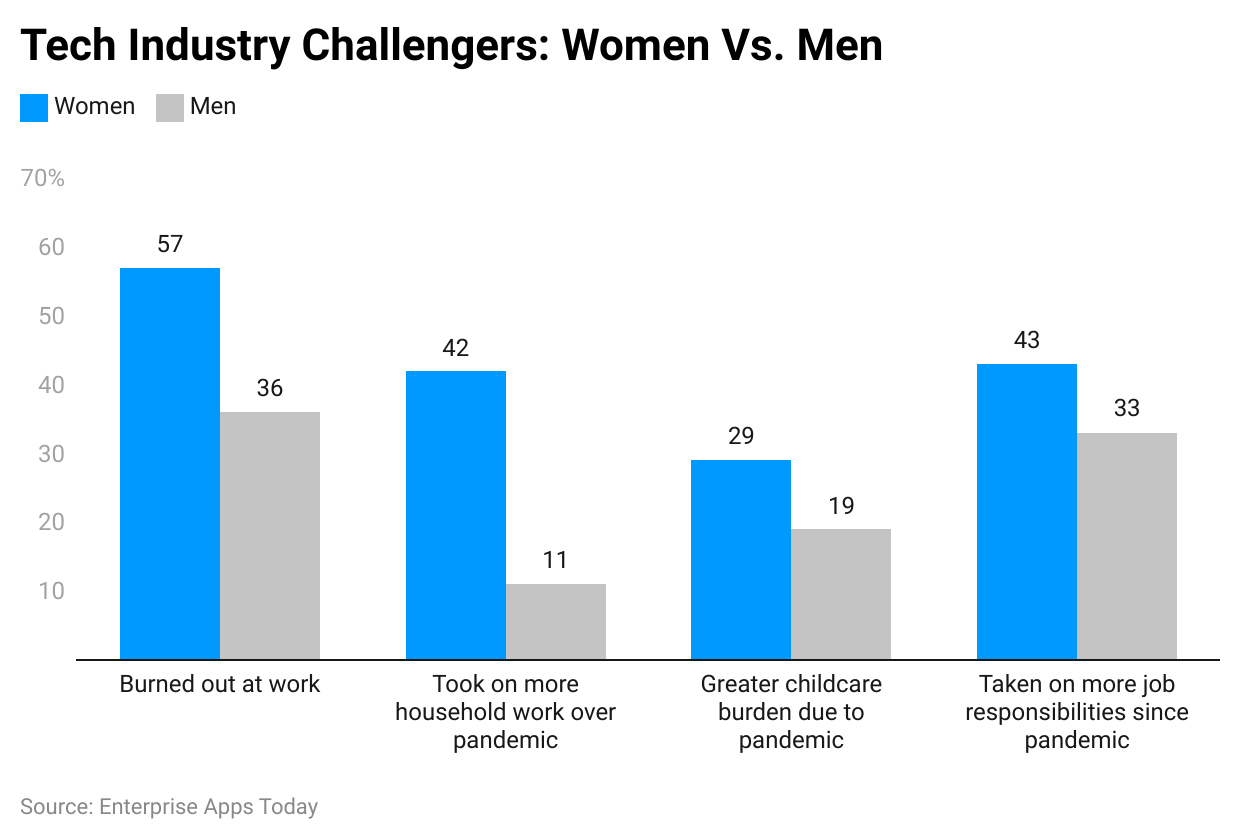 (Source: ZIPPIA)
(Source: ZIPPIA)
- According to Women in Technology statistics, 57% of women feel burned out at work while only 36% of the male feel the same.
- 42% of the women said they took on more household work during the pandemic while 11% of the men said similar.
- 29% and 19% female to male ratio said they felt the highest level of burden of childcare during the pandemic.
- While 43% of the tech industry female employees said to have taken more job responsibilities after the pandemic and 33% of male employees in the same industry said the same.
By Job Satisfaction Factors
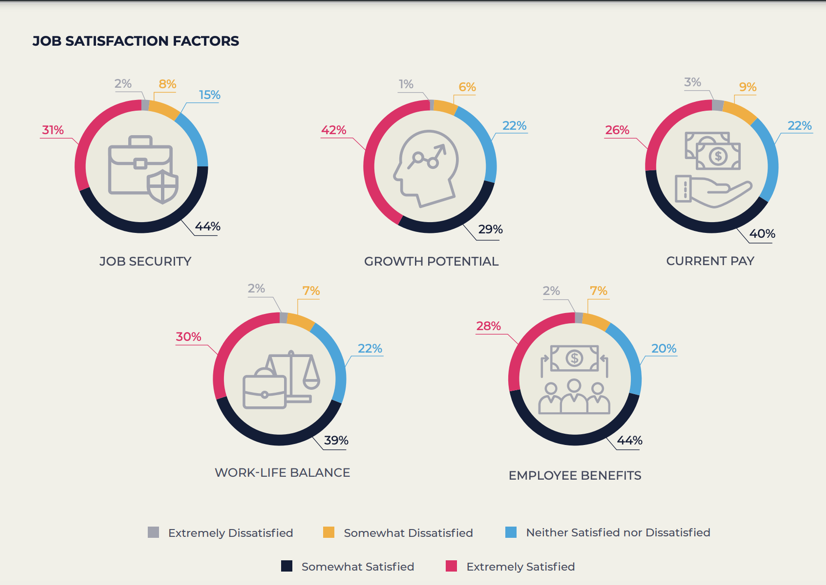 (Source: skillsoft.com)
(Source: skillsoft.com)
- According to Women in Technology statistics, females who work in tech companies have various factors in job satisfaction as follows –
Job Security
- 44% of the female employees in tech companies are somewhat satisfied with job security.
- 31% of the female employees are extremely satisfied, while 15% are dissatisfied, 8% and 2% are somewhat dissatisfied and extremely dissatisfied respectively.
Growth Potential
- 42% of the women in technology say that they are extremely satisfied with the growth in their careers.
- While 29% of the women are somewhat satisfied.
- 22% of the female in technology say that they are dissatisfied with their career growth.
- The remaining 6% and 1% respectively say that they are somewhat and extremely satisfied.
Current Pay
- 40% of the women in technology are somewhat happy with their current salary.
- 26% and 22% of females are extremely happy while the remaining are dissatisfied.
- The current pay satisfaction rate is divided further into 9% and 3% in women in tech for somewhat dissatisfied and extremely dissatisfied.
Work-Life Balance
- 39% of the women working in tech say that they get somewhat work-life balance while 30% are extremely happy with their work-life balance.
- The remaining 22%, 7%, and 2% have negative minds about work-life balance in tech companies.
Employee Benefits
- 44% of the women say that they are somewhat happy with the employee benefits their company is providing, while 28% of women say they are a cent percent happy with the employee benefits.
- On the other hand, overall, 29% of the female employees in the tech industry are not happy with the employee benefits on various levels.
By Skills
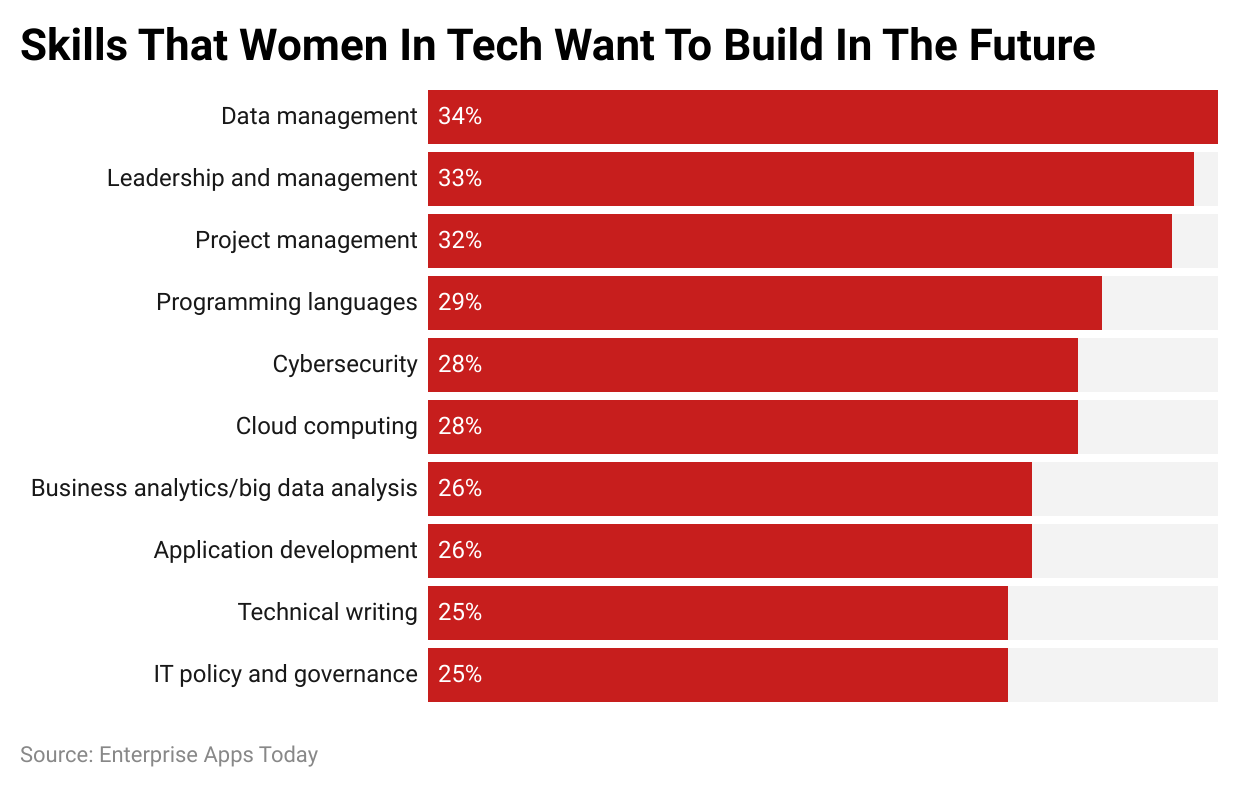
(Source: skillsoft.com)
- There 34% of women want to build their skills in data management.
- 33% of women want to grow their future in leadership and management while 32% want a career in project management.
- While 29% of the female want to land a career in programming languages.
- 28% of the women are willing to gain a future in a cloud computing career while 26% belong to business analytics and application development.
- 25% of the women respectively wish to work in a career in technical writing and IT policy and governance.
Trends In Women in Technology
- Declining Representation: The percentage of women in tech roles has seen a downward trend, dropping to 32%.
- Educational Shifts: Despite equal opportunities, there's a decline in women pursuing STEM degrees, with only 18% earning new computer science degrees.
- Venture Capital Allocation: Funding for all-women startup teams hit a record low of 1.9% in 2022, indicating a concerning trend in VC investment.
- Pay Disparity: Black women CEOs receive 38% less pay compared to their white male counterparts, highlighting ongoing gender pay gaps.
- Job Attrition: A significant portion, 50%, of women in tech leave their jobs before turning 35, suggesting challenges in retaining female talent.
- Workplace Challenges: More than 50% of women in tech report facing harassment, sexism, or discrimination in male-dominated environments.
- Diversity Struggles: Despite efforts, only 3% of women in tech identify as Black, while just 1.7% identify as Latinx, indicating persistent diversity challenges.
- Investment Disparities: Women founders secure just 2% of venture capital funding, underscoring the need for increased investment in women-led ventures.
- Leadership Trends: The percentage of women in tech leadership roles has decreased to 28% in 2023, signaling a concerning trend in gender representation at higher levels.
Recent Development in Women in Technology
- Investment Landscape: All-women startup teams received only 1.9% of venture capital funding in 2022, showcasing persistent challenges in securing investment.
- Retention Challenges: Despite efforts, 50% of women in tech leave their jobs before turning 35, highlighting the need for improved retention strategies.
- Workplace Environment: Over 50% of women in tech report experiencing harassment, sexism, or discrimination, emphasizing the importance of fostering inclusive workplaces.
- Leadership Representation: The percentage of women in tech leadership roles has declined to 28% in 2023, underscoring persistent challenges in achieving gender parity at higher levels.
- Diversity Initiatives: Businesses implementing intersectional pay audits are hiring women at 1.3 times the rate of other companies, signaling the positive impact of diversity initiatives.
Conclusion
In conclusion, the statistics regarding women in technology underscore both progress and persistent challenges in the industry. With only 26.7% of tech-related jobs held by women and 28% leaving due to limited career growth, there remains significant room for improvement in fostering gender diversity. Additionally, the preference for remote work among 34% of women highlights the evolving nature of work arrangements in the tech sector.
Despite efforts to address gender inequality, such as the 39% reporting gender bias hindering promotion opportunities, there's still work to be done. The impact of the pandemic is evident, with over 50% of women facing workplace difficulties. Furthermore, the disparity in venture capital funding, where all-women startup teams received a mere 1.9% of total funding in 2022, signals ongoing systemic challenges. As market research analysts, it's crucial to recognize these statistics and advocate for policies and practices that promote inclusivity and equal opportunities for women in technology.
Sources
FAQ.
Google has been listed on top for offering the highest tech-related jobs for women resulting in 25% of the female workforce.
Canada offers better tech-related opportunities to women than men resulting in 61.3%
Data management and could computing in tech are leading sectors for women as well as offer career growth.
Yes of course. But better pay depends on the company culture. But at an individual level, a woman can earn equal to a man.

Barry is a lover of everything technology. Figuring out how the software works and creating content to shed more light on the value it offers users is his favorite pastime. When not evaluating apps or programs, he's busy trying out new healthy recipes, doing yoga, meditating, or taking nature walks with his little one.